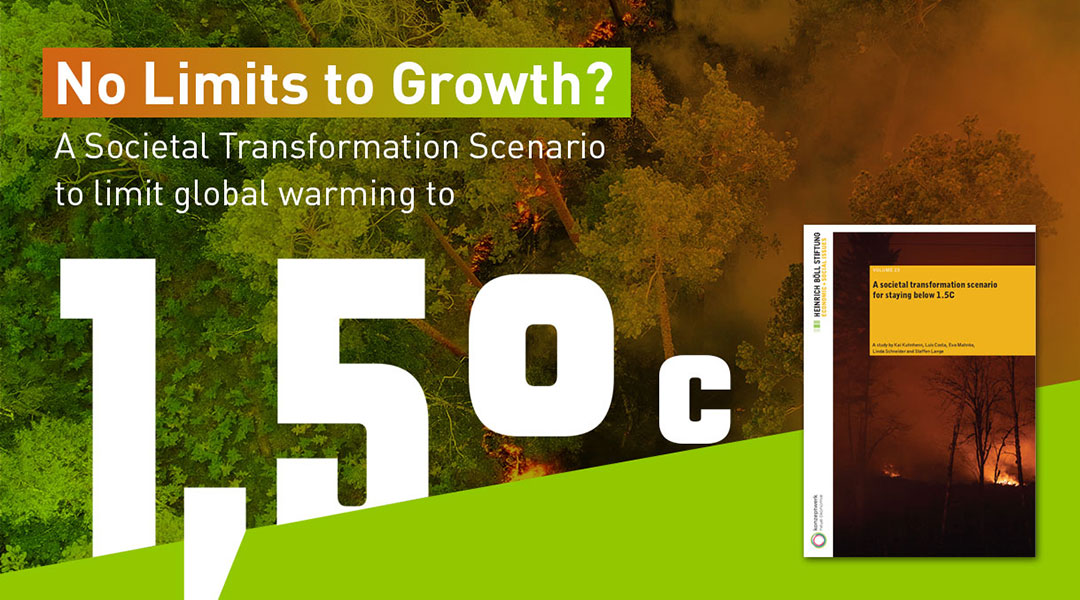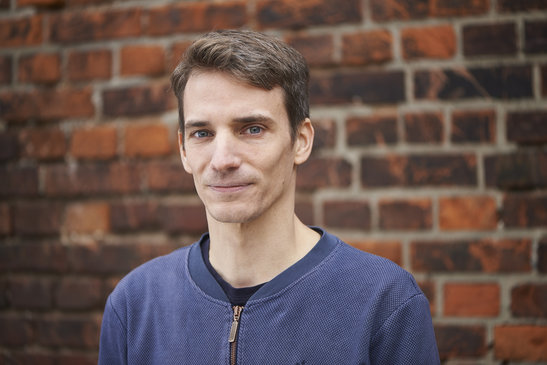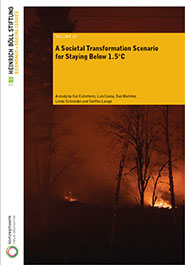
No Limits to Growth?
A Societal Transformation Scenario to limit global warming to 1,5°C
A study by Kai Kuhnhenn, Luis Costa, Eva Mahnke, Linda Schneider and Steffen Lange
December 9th, 2020
The „Societal Transformation Scenario“ is a joint publication by Konzeptwerk Neue Oekenomie (Leipzig, Germany) and Heinrich Boell Foundation. Together with researchers from engineering and the natural and social sciences, we think that it is increasingly pressing to start developing global climate mitigation scenarios that explore the climate effects of envisioning a broader societal transformation, including introducing limits on production and consumption in key high-emission sectors in the Global North.
The „Societal Transfomation Scenario“ is a global 1.5°C mitigation scenario, which challenges the notion of perpetual global economic growth and its compatibility with ambitious climate goals like the 1.5°C limit. It shows how through a reduction of production and consumption in the Global North, we can stay below 1.5°C without resorting to high-risk technologies like CCS, geoengineering and nuclear, while also avoiding temperature overshoot.
We hope that the scenario sparks new conversations about climate mitigation pathways, conversations that do not only revolve around questions about technology and cost but that deal with the much more pressing matter of achieving a good life for all.
F.A.Q.s
What is the STS? How does it differ from 1.5°C pathways covered in IPCC reports?
The Societal Transformation Scenario (STS) is a climate mitigation scenario that distinguishes itself from the scenarios cited by the IPCC in that it assumes a socio-ecological transformation, leading to a better life while reducing consumption and production in the Global North. The scenarios so far covered by the IPCC usually portray a world that sees no radical societal change, and has global GDP to rising until 2100 in all regions. Since economic growth is a major driver of greenhouse gas (GHG) emissions, these scenarios often rely on high-risk Carbon Dioxide Removal technologies and on a dangerous “overshoot” of the 1.5°C limit.
Is the STS a technological-sceptical scenario?
No. The STS assumes ambitious technological development in the fields of renewable energy and efficiency increases. These advances are fundamental in limiting greenhouse gas emissions. We do, however, believe that they should work in tandem with societal transformation towards less consumption and production and not in tandem with high-risk technological measures such as “negative emissions” geoengineering technologies.
Which assumptions does the STS make for individual sectors – globally and in countries of the Global North?
In the STS we focused on some key areas of consumption for the Global North: transport, housing and food. Our assumptions are:
- Transport: a reduction of road-based transport due to a relocalization of economies, and better local infrastructure. The remaining personal transport shifts away from cars to public transport, cycling and walking.
- Housing: a 25% reduction of personal living space (on average) as well as a halving of large household appliances per person.
- Food: a reduction in food waste and in meat consumption.
For the countries of the Global South, we do not assume those same levels of reduction, but instead an increase in consumption levels, leading to a convergence of consumption patterns of the Global South with those of the Global North in 2050.
The STS assumes reductions in consumption and production in the Global North. How can social hardships associated with these reductions be prevented?
Reductions of consumption and production without any larger societal change lead to economic recession and social hardships. That is why we assume this reduction to be a necessary part of a broader radical socio-ecological transformation. Such a transformation is not primarily about producing and consuming less but instead about fulfilling concrete human needs, redistributing wealth and serving common welfare – fostering cooperation, care, solidarity and sustainability to achieve a good life for all. Important (first) changes in this regard are taxing resources instead of labour, making social protection systems independent of economic growth, reducing working hours, introducing basic incomes and a maximum wage, decelerating life and democratising (economic) decision-making. Although these changes might not all have a direct material impact on GHG emissions, they are prerequisites to increasing human well-being while reducing material consumption. They would facilitate a transformation away from everlasting economic growth that is undermining life and livelihoods on this planet.
The STS was developed on the basis of the Global Calculator (GC). Why did you choose such a simple and transparent model for the STS?
Global mitigation scenarios are typically modelled using so-called Integrated Assessment Models. These are highly complex models that remain largely inaccessible to the broader public: Many ethical questions and predictions are hidden in their assumptions and algorithms, making it difficult to reproduce and understand their results. These models have their place in assessing short- or even mid-term scenarios. When looking at 2050 or 2100, however, we believe that transparent tools are needed that enable a democratic debate about our common future. While not perfect, we believe that the Global Calculator is a step in this direction.
What are the limitations of the STS and of the Global Calculator?
In general, the Global Calculator (GC) is a model in which the user has to make the choices, e.g. about consumption levels, technological advances, population dynamics etc. Other models, such as IAMs, have decision-making algorithms that, for instance, make decisions about which migitation measures should be implemented based on cost assumptions (e.g. build up offshore wind power or insulate buildings?). We see this as an advantage of the GC.
In its original form, the GC does not distinguish between world regions and does not allow for changing some of the consumptions parameters in the way we wanted to. We therefore did not work with the web-based version but with the spreadsheet model that it is based on. In this model we divided up the consumption side into two regions – Annex I countries and Non-Annex I countries.
Finally and in general, global emission models are relatively crude instruments. Due to the complexity and non-linearity of the real world, any attempt at reproducing or forecasting its inner workings is extremely difficult. Thus, the results of global emission models, regardless of their character, come with myriads of reservations. These reservations stem from the models’ assumptions and extrapolations many decades into the future, and their high levels of abstraction.
What are the results of the STS?
The STS is an invitation for debate around climate mitigation, the role of production and consumption, and deeper societal transformation. What are the questions that should emerge from this in the scientific community and in broader society?
The main question we see for society and science is whether we want to continue on the path of our current economic system that relies on ever increasing production and consumption, or whether we want – and need – to depart from this path. This leads to even more profound questions around how we want to live in the future under conditions of the climate crisis.
For science, this perspective calls for answers to a number of questions: How can science facilitate these public debabtes? What kind of tools are needed for this? How do we discuss, and find answers to, global crises such as environmental destruction, social injustice and the climate crisis in an integrated fashion? What do research teams need to look like to be able to make meaning connections between these issues?


